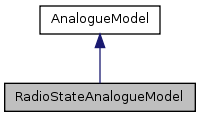This special AnalogueModel provides filtering of a Signal according to the actual RadioStates the Radio were in during the Signal's time interval. More...
#include <PhyUtils.h>
Inherits AnalogueModel.

Classes | |
| class | ListEntry |
| Data structure for the list elements. More... | |
Public Member Functions | |
| RadioStateAnalogueModel (double initValue, bool currentlyTracking=false, simtime_t initTime=0) | |
| Standard constructor for a RadioStateAnalogueModel instance. | |
| virtual void | filterSignal (Signal &s) |
| Filters the Signal according to the RadioState (passively), i.e. adding an appropriate instance of RSAMMapping to the Signal. | |
| void | setTrackingModeTo (bool b) |
| sets tracking mode | |
| void | cleanUpUntil (simtime_t t) |
| Cleans up all stored information strictly before the given time-point, i.e. all elements with their time-point strictly smaller than given key. That means multiple entries with same time are preserved. | |
| void | writeRecvEntry (simtime_t time, double value) |
| Stores an entry of the form "time-point/attenuation (from now on)". | |
Protected Attributes | |
| bool | currentlyTracking |
| Indicator variable whether we are currently tracking changes. | |
| std::list< ListEntry > | radioStateAttenuation |
| Data structure to track the Radios attenuation over time. | |
Friends | |
| class | RSAMMapping |
| class | RSAMConstMappingIterator |
Detailed Description
This special AnalogueModel provides filtering of a Signal according to the actual RadioStates the Radio were in during the Signal's time interval.
This AnalogueModel models the effects of the radio state on the received signal. This effects are for example total attenuation during the time the radio is not in receiving state. And no attenuation at all if it is in receiving state.
This way it is assured that the received power calculated for a Signal by use of the AnalogueModels really is the power received, means if the radio is not in receiving state then this is reflected by the received power of the signal. Therefore the Decider which evaluates the receiving power doesn't have to care about if the radio was in correct state to actually receive a signal. It just has to check if the receiving power was/is high enough.
A state-machine-diagram for Radio, RadioStateAnalogueModel and ChannelInfo showing how they work together under control of BasePhyLayer as well as some documentation on how RadioStateAnalogueModel works is available in phyLayer - physical layer modules.
Definition at line 40 of file PhyUtils.h.
Constructor & Destructor Documentation
| RadioStateAnalogueModel::RadioStateAnalogueModel | ( | double | initValue, | |
| bool | currentlyTracking = false, |
|||
| simtime_t | initTime = 0 | |||
| ) | [inline] |
Standard constructor for a RadioStateAnalogueModel instance.
Default setting is: tracking off
Definition at line 120 of file PhyUtils.h.
References radioStateAttenuation.
: currentlyTracking(currentlyTracking) { // put the initial time-stamp to the list radioStateAttenuation.push_back(ListEntry(initTime, initValue)); }
Member Function Documentation
| void RadioStateAnalogueModel::cleanUpUntil | ( | simtime_t | t | ) |
Cleans up all stored information strictly before the given time-point, i.e. all elements with their time-point strictly smaller than given key. That means multiple entries with same time are preserved.
Intended to be used by the PhyLayer
THIS SHOULD BE THE ONLY WAY TO DELETE ENTRIES IN THE RECEIVING LIST
Definition at line 14 of file PhyUtils.cc.
References radioStateAttenuation.
Referenced by Radio::cleanAnalogueModelUntil(), and writeRecvEntry().
{
// assert that list is not empty
assert(!radioStateAttenuation.empty());
/* the list contains at least one element */
// CASE: t is smaller or equal the timepoint of the first element ==> nothing to do, return
if ( t <= radioStateAttenuation.front().getTime() )
{
return;
}
// CASE: t is greater than the timepoint of the last element
// ==> clear complete list except the last element, return
if ( t > radioStateAttenuation.back().getTime() )
{
ListEntry lastEntry = radioStateAttenuation.back();
radioStateAttenuation.clear();
radioStateAttenuation.push_back(lastEntry);
return;
}
/*
* preconditions from now on:
* 1. list contains at least two elements, since 2. + 3.
* 2. t > first_timepoint
* 3. t <= last_timepoint
*/
// get an iterator and set it to the first timepoint >= t
std::list<ListEntry>::iterator it;
it = lower_bound(radioStateAttenuation.begin(), radioStateAttenuation.end(), t);
// CASE: list contains an element with exactly the given key
if ( it->getTime() == t )
{
radioStateAttenuation.erase(radioStateAttenuation.begin(), it);
return;
}
// CASE: t is "in between two elements"
// ==> set the iterators predecessors time to t, it becomes the first element
it--; // go back one element, possible since this one has not been the first one
it->setTime(t); // set this elements time to t
radioStateAttenuation.erase(radioStateAttenuation.begin(), it); // and erase all previous elements
}
| void RadioStateAnalogueModel::filterSignal | ( | Signal & | s | ) | [virtual] |
Filters the Signal according to the RadioState (passively), i.e. adding an appropriate instance of RSAMMapping to the Signal.
The Signal is added a new RSAMMapping that has a pointer to this instance RadioStateAnalogueModel, hence the pointer is valid as long as the Radio instance exists that has this RSAM as a member.
Implements AnalogueModel.
Definition at line 5 of file PhyUtils.cc.
References Signal::addAttenuation(), Signal::getSignalLength(), and Signal::getSignalStart().
{
simtime_t start = s.getSignalStart();
simtime_t end = start + s.getSignalLength();
RSAMMapping* attMapping = new RSAMMapping(this, start, end);
s.addAttenuation(attMapping);
}
| void RadioStateAnalogueModel::writeRecvEntry | ( | simtime_t | time, | |
| double | value | |||
| ) |
Stores an entry of the form "time-point/attenuation (from now on)".
Intended to be used by the Radio
Definition at line 66 of file PhyUtils.cc.
References cleanUpUntil(), currentlyTracking, and radioStateAttenuation.
Referenced by Radio::makeRSAMEntry().
{
// bugfixed on 08.04.2008
assert( (radioStateAttenuation.empty()) || (time >= radioStateAttenuation.back().getTime()) );
radioStateAttenuation.push_back(ListEntry(time, value));
if (!currentlyTracking)
{
cleanUpUntil(time);
assert(radioStateAttenuation.back().getTime() == time);
}
}
The documentation for this class was generated from the following files:
- base/phyLayer/PhyUtils.h
- base/phyLayer/PhyUtils.cc
 1.7.1
1.7.1